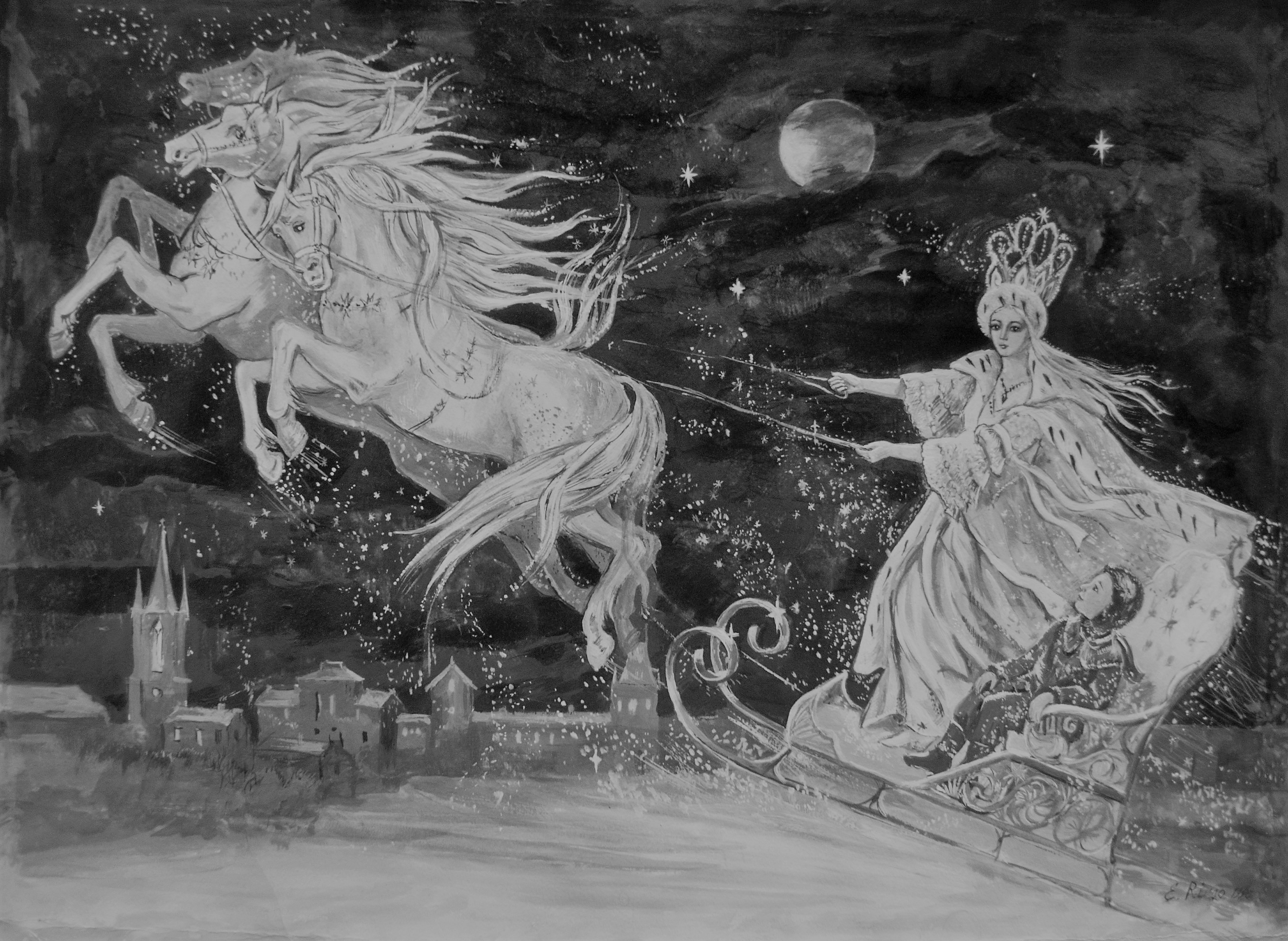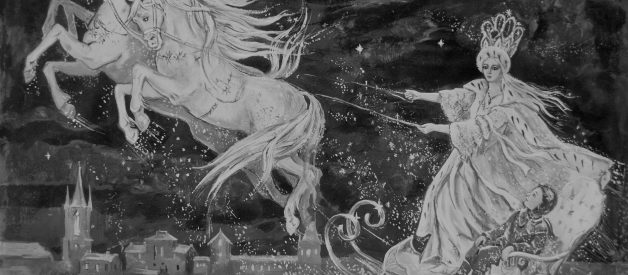The original story of strength and endurance behind childlike friendship

First published on December 1844, Snedronningen or The Snow Queen has fascinated many, one of which was none other than Disney Producer, Peter Del Vecho. Fueled by inspiration from Hans Christian Andersen?s fairy tale, Disney?s Frozen was produced, and then premiered in 2013, generating close to 1.3 billion USD in the box office.
Yet, Frozen is pretty much an original, with a story of its own that pays homage to Snedronningen through its featuring of the integral themes of The Snow Queen: family, love, and inner-strength. These messages are, however, delivered in a different tone and manner. The original fairy tale, unlike its fun-filled and song-inciting descendant, is a little less of a straight shooter. Breaking his tale up into seven short stories, Hans Christian Andersen brings the reader on an epic, confusing adventure, laced with ambiguous messages and intricate complexities.
The First Book: a Looking-Glass and the Broken Fragments
This chapter tells of a devil making a mirror that only reflects what is ugly and hateful for his mere amusement. In his attempt to bring the mirror to heaven to spite the holy, the mirror breaks into a million brilliant pieces, each retaining the evil magic imbued in the mirror. The shattered pieces then spread with the wind, getting into people?s eyes and hearts, making them see only the bad in things.
However, it is left ambiguous to the fragments? true effect, with Andersen inserting an additional layer of what the mirror really did from the point of view of the devil and the students of his kind.
??for the first time one could really see, they felt, what the world and people really looked like?
The Second Book: a Little Boy and a Little Girl
Kay and Gerda, children as close as brother and sister, were told the story of the Snow Queen, who makes a brief appearance to Kay.
?She was very fine and beautiful, but made of ice, of blinding, twinkling ice, and yet she was alive; her eyes stared like two bright stars, although there was no calmness or rest in them.?
Kay is later struck by one of the broken fragments of the mirror, gaining seemingly heightened intelligence (at the cost of his heart freezing) that resulted in his disengagement from stories (that his grandmother tells him) and relationships. He is then taken away by the Snow Queen.
Andersen stylizes the story metaphorically to suggest that the abandonment or disregard of stories and love is congruent to spiritual death ? a death that often goes unnoticed.
??it was as if he was going to die; ? but only for a moment, then it felt fine; he could no longer notice the cold around him.?
The Third Book: the Flower Garden of the Woman Who Could Conjure
After his disappearance, Gerda wonders if Kay is alive and leaves home to search for her friend. She meets a witch and asks the witch?s flowers for help in her quest. The flowers each sang their own story?
?There was such a sweet scent, and the girls went off into the forest: the scent grew stronger ? three coffins, in which the lovely girls lay down?Are the dancing girls asleep, or are they dead??
?,though intriguing, none of which was related to Kay.
?We do not toll for Kay, him we do not know! we are just singing our song, the only one we know!?
The flowers and their stories are often seen as Andersen?s portrayal of self-involvement ? something that Gerda had to forsake and abandon in order to continue on her journey to find her loved friend. The scene he paints has also often been construed to be an intentional mockery of the thoughts and writings of intellectuals that bored Andersen to pieces.
??I don?t care about that!? Gerda said. ?That?s nothing to tell me about!??
The Fourth Book: the Prince and Princess
In this chapter, Gerda runs into a crow, who misinformed her of Kay?s living with a princess. She goes to find him, only to learn of the crow?s mistake. However, the prince and princess she finds empathized with her situation and gave her a carriage to continue her search for Kay.
In between the happenings of the chapter, Anderson writes about the irony of how shared feelings of loneliness could lead to friendship?
?The word ?alone? Gerda understood perfectly well and was well aware how much meaning lay in it, and so she told the crow about herself and her entire life??
?along with further mockery of those who identify as intellectuals.
??a princess who is so immensely clever?she has also read all the newspaper that exist in the world, and forgotten them again ? she is that clever.?
The Fifth Book: Little Robber-Girl
Gerda?s carriage is sacked by robbers, with a little robber-girl claiming Gerda as her new captive playmate. She tells the little robber-girl and a few pigeons about her quest for Kay. The pigeons inform her of Kay and the Snow Queen, and the little robber-girl releases Gerda along with a captive reindeer who promises to bring Gerda to the Snow Queen. They then head north to rescue Kay.
Here, Andersen tells of how love can overcome the evil in a person and move even the cruel, with his depiction of a sadistic robber-girl who, despite her nature, is touched by Gerda?s feelings and goes against her usual behavior to help Gerda out.
??(the robber girl) said ?I really have this peculiar urge to tickle you many more times with the sharp knife, for you are such fun then, but no matter ? I will loosen your rope and help you outside, so you can run off???
The Sixth Book: the Lapland Woman and the Finland Woman
The reindeer and Gerda encountered a Lapland woman who directed them to her friend, a Finland woman, who coincidentally, is also a witch. The reindeer asks the witch to bestow upon Gerda the power to overcome anything and everything, to which the Finland witch replies that she can be of no help; not because of her incapacity but rather, Gerda?s favored disposition.
??I can?t give her greater power than she already has! can?t you see how great that is? Can?t you see how humans and animals have to serve her, how she has managed to get so far in the world on her own bare feet. She must not be told of her power by us, it resides in her heart, it exists because she is a sweet innocent child???
They continue on their journey and arrive at the Snow Queen?s place where they are attacked by the guards ? large, living snowflakes. In a scene telling of Andersen?s religious beliefs, Gerda recited ?her Lord?s Prayer?, defeating the guards in the process, bringing to life on the pages of the fairy tale the very act of ?praying one?s way through terrible weather?.
?her breath became increasingly dense and formed itself into small bright angels that grew larger and larger when they touched the ground; and all of them were wearing helmets on their heads and were holding spears and shields in their hands; they grew in number and when Gerda had finished her Lord?s Prayer, there was a whole legion around her?and little Gerda was able to move on safe and undaunted.?
The Seventh Book: the Palace of the Snow Queen and What Happened There At Last
With the Snow Queen (conveniently) away from her dwellings, Gerda finds a near-frozen-to-death Kay and rescues him from the magic of the cursed mirror and his frozen heart.
??little Greda cried hot tears, they fell on his chest, they managed to enter his heart, they thawed the lump of ice and consumed the tiny fragment of mirror inside??
The story then ends with Greda and Kay returning to their home, where they noticed that they have already grown into adults.
?There they sat, two grown-ups and yet children, children at heart, and it was summer, warm, wonderful summer.?
Amongst the many complexities of the fairy tale, a widely-discussed favorite is the mixed signals Andersen sends regarding intellectualism and love, and who the ultimate victor is. Though Kay became trapped by his own intellect and thoughts, Greda, though free of the curse of the glass, repeatedly fails in seeing things for what they truly are. To further propagate the ambiguity, Andersen punishes many minor characters that are motivated by love (such as the flowers and the crow) while letting the characters that are portrayed to favor reason (such as the Snow Queen and the Devil) get away scot-free.
Regardless, the tale of a little girl, with the help of unlikely, marginalized characters (such as robbers, crows, and witches) magnificently delivers the intended message: that with grit and love, the powerless and marginalized can even triumph over the powerful.
Thank you for reading! Share your thoughts, for they are most welcome, and remember to recommend it to someone that may enjoy the read!
If you are interested, you can get a copy of Andersen?s The Snow Queen here


